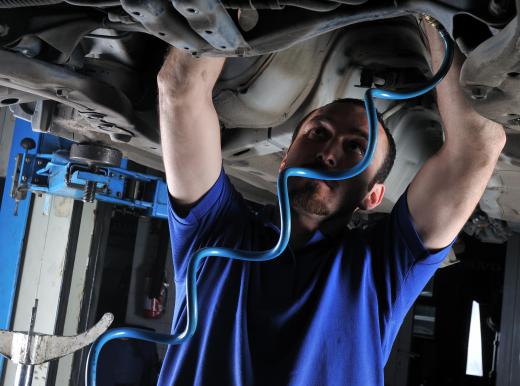An industrial hose is any hose designed specifically to safely withstand the extreme pressures or temperatures and resist the attacks of caustic or abrasive chemicals associated with industrial processes. Industrial hoses may consist of loose lengths or prefabricated modular units which include application specific fittings. These hoses are typically constructed with a flexible outer sheath of chemical, heat, and lubricant resistant rubber reinforced at various points with a textile or metal braided sheath. The union between the hose and fittings are also designed to carry high pressures, and the fittings themselves are typically robust, heavy duty variants. Industrial hoses are generally used in hydraulic, pneumatic, high pressure lubrication, and chemical process systems.
Hoses destined for use in industrial processes generally have to contend with four factors which the common garden hose doesn't. These are high pressure, temperature extremes, mechanical stress, and chemical attack. Some industrial hose types have to deal with most if not all of the above as part of their regular operational regimens. These four aggressive environmental factors are countered in different ways and which may be applied separately or collectively depending on the hoses' end use.

High pressure industrial hose intended for use on hydraulic and pneumatic systems is typically reinforced in a number of ways to withstand the high operational pressures. Moderate pressure system hoses may have no more than a simple twine mesh laminated into the hose rubber to add additional reinforcement. Those intended for use on high pressure systems will have one or more stainless steel or brass braided sheaths included in the rubber or along the outside of the hose. Some high pressure hoses have stainless steel helical coils included in their construction to serve the same purpose. All of these additional elements physically reinforce the hoses against the expansion stresses of carrying high pressure fluids and gases.
Braids and coil sheaths also protect hoses against mechanical stress such as pinching, chaffing, and impact. High and low temperatures are countered in the chemical make up of the hose material itself. The inclusion of silicone and polymer compounds greatly increases the amount of extreme heat or cold the hose rubber can endure before it starts to break down. Chemical and lubricant resistance is built into the industrial hose in the same fashion with specially formulated rubber compounds used in the manufacture of the hose itself. These compounds resist the attacks of acids and alkaline mediums as well as the degradation caused by hydraulic and lubricating oils.
The rugged nature of industrial hoses extends to the fittings used to terminate them. Many types of industrial hose are available in prefabricated lengths which include application appropriate fittings. These fittings are usually heavy duty varieties and are crimped onto the hose using pressure resistant collars. These hoses are typically used on specific machines and processes and are custom made to be of the correct length, rating, and fitting type off the shelf.
